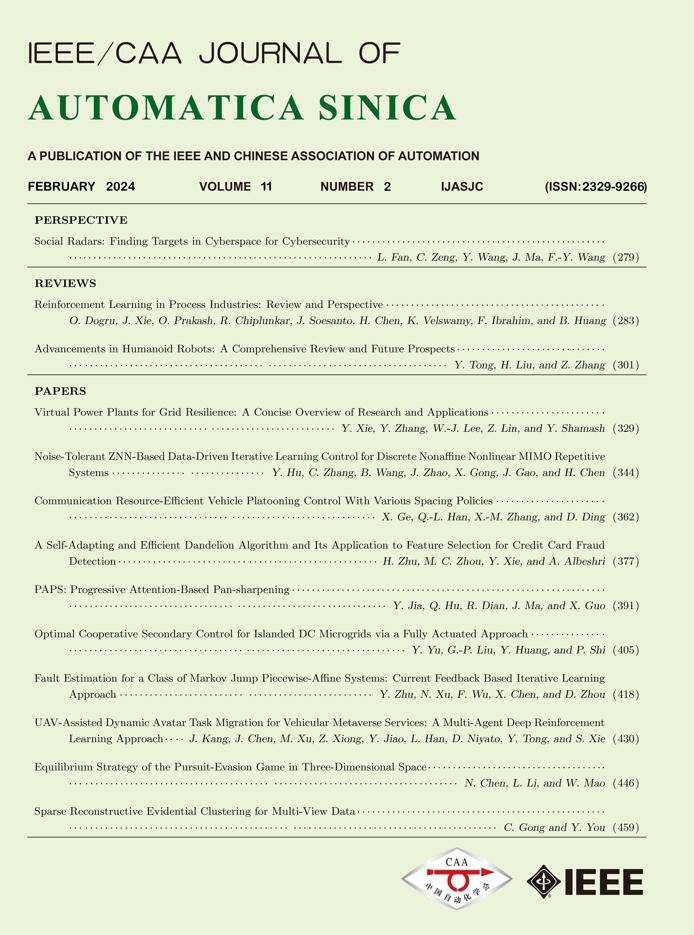 Volume 11
Issue 2
Volume 11
Issue 2
IEEE/CAA Journal of Automatica Sinica
| Citation: | Z. Wang, X. Jin, T. Zhang, and D. Yu, “A finite-time convergent analysis of continuous action iterated dilemma,” IEEE/CAA J. Autom. Sinica, vol. 11, no. 2, pp. 563–565, Feb. 2024. doi: 10.1109/JAS.2023.123606 |

| [1] |
G. Zhao, Y. Wang, and H. Li, “A matrix approach to the modeling and analysis of networked evolutionary games with time delays,” IEEE/CAA J. Autom. Sinica, vol. 5, no. 4, pp. 818–826, 2016.
|
| [2] |
M. A. Amaral, M. M. de Oliveira, and M. A. Javarone, “An epidemiological model with voluntary quarantine strategies governed by evolutionary game dynamics,” Chaos,Solitons &Fractals, vol. 143, p. 110616, 2021.
|
| [3] |
Z. Wang, D. Hou, C. Gao, J. Huang, and Q. Xuan, “A rapid source localization method in the early stage of large-scale network propagation,” in Proc. ACM Web Conf., 2022, pp. 1372–1380.
|
| [4] |
Z. Wang, M. Jusup, H. Guo, et al., “Communicating sentiment and outlook reverses inaction against collective risks,” Proc. National Academy of Sciences, vol. 117, no. 30, pp. 17650–17655, 2020. doi: 10.1073/pnas.1922345117
|
| [5] |
S.-P. Zhang, J.-Q. Zhang, L. Chen, and X.-D. Liu, “Oscillatory evolution of collective behavior in evolutionary games played with reinforcement learning,” Nonlinear Dynamics, vol. 99, no. 4, pp. 3301–3312, 2020. doi: 10.1007/s11071-019-05398-4
|
| [6] |
Z. Tian, X. Gao, S. Su, J. Qiu, X. Du, and M. Guizani, “Evaluating reputation management schemes of internet of vehicles based on evolutionary game theory,” IEEE Trans. Vehicular Technology, vol. 68, no. 6, pp. 5971–5980, 2019. doi: 10.1109/TVT.2019.2910217
|
| [7] |
Y. Xiao, D. Chen, S. Wei, Q. Li, H. Wang, and M. Xu, “Rumor propagation dynamic model based on evolutionary game and anti-rumor,” Nonlinear Dynamics, vol. 95, no. 1, pp. 523–539, 2019. doi: 10.1007/s11071-018-4579-1
|
| [8] |
J. Zhang, J. Lou, J. Qiu, and J. Lu, “Dynamics and convergence of hyper-networked evolutionary games with time delay in strategies,” Information Sciences, vol. 563, pp. 166–182, 2021. doi: 10.1016/j.ins.2021.02.033
|
| [9] |
Y. Zheng, C. Li, and J.-E. Feng, “Modeling and dynamics of networked evolutionary game with switched time delay,” IEEE Trans. Control Network Systems, vol. 8, no. 4, pp. 1778–1787, 2021. doi: 10.1109/TCNS.2021.3084548
|
| [10] |
T. Mai, H. Yao, N. Zhang, L. Xu, M. Guizani, and S. Guo, “Cloud mining pool aided blockchain-enabled internet of things: An evolutionary game approach,” IEEE Trans. Cloud Computing, vol. 11, no. 1, pp. 692–703, 2023. doi: 10.1109/TCC.2021.3110965
|
| [11] |
B. Ranjbar-Sahraei, H. Bou Ammar, D. Bloembergen, K. Tuyls, and G. Weiss, “Evolution of cooperation in arbitrary complex networks,” in Proc. Int. Conf. Autonomous Agents and Multi-Agent Systems, 2014, pp. 677–684.
|
| [12] |
Y. Liu, J.-W. Wang, Z. Wu, Z. Ren, and S. Xie, “Robust $ {\cal{H}}_{\infty}$ control for semilinear parabolic distributed parameter systems with external disturbances via mobile actuators and sensors,” IEEE Trans. Cyber., vol. 53, no. 8, pp. 4880–4893, 2023. doi: 10.1109/TCYB.2022.3150171
|
| [13] |
F. Tatari, H. Modares, C. Panayiotou, and M. Polycarpou, “Finite-time distributed identification for nonlinear interconnected systems,” IEEE/CAA J. Autom. Sinica, vol. 9, no. 7, pp. 1188–1199, 2022. doi: 10.1109/JAS.2022.105683
|
| [14] |
T. Zhang, D. Yu, Z. Wang, X. Jin, S. Li, and F. Du, “Finite-time consensus tracking for multi-motor system based on sliding mode control,” in Proc. 6th Int. Conf. Robotics and Automation Engineering, 2021, pp. 102–107.
|
| [15] |
H. Xu, D. Yu, S. Sui, and C. Chen, “An event-triggered predefined time decentralized output feedback fuzzy adaptive control method for interconnected systems,” IEEE Trans. Fuzzy Systems, vol. 31, no. 2, pp. 631–644, 2023. doi: 10.1109/TFUZZ.2022.3184834
|
| [16] |
D. Yu, H. Xu, C. P. Chen, W. Bai, and Z. Wang, “Dynamic coverage control based on k-means,” IEEE Trans. Industrial Electronics, vol. 69, no. 5, pp. 5333–5341, 2021.
|
| [17] |
L. Wang and F. Xiao, “Finite-time consensus problems for networks of dynamic agents,” IEEE Trans. Automatic Control, vol. 55, no. 4, pp. 950–955, 2010. doi: 10.1109/TAC.2010.2041610
|
| [18] |
Z. Zhao and Z. Liu, “Finite-time convergence disturbance rejection control for a flexible timoshenko manipulator,” IEEE/CAA J. Autom. Sinica, vol. 8, no. 1, pp. 157–168, 2020.
|
| [19] |
Z.-Y. Sun, Y. Shao, and C.-C. Chen, “Fast finite-time stability and its application in adaptive control of high-order nonlinear system,” Automatica, vol. 106, pp. 339–348, 2019. doi: 10.1016/j.automatica.2019.05.018
|
| [20] |
R. Olfati-Saber and R. M. Murray, “Consensus problems in networks of agents with switching topology and time-delays,” IEEE Trans. Automatic Control, vol. 49, no. 9, pp. 1520–1533, 2004. doi: 10.1109/TAC.2004.834113
|